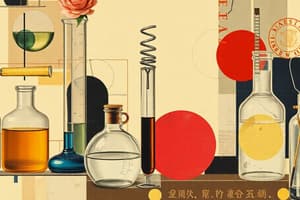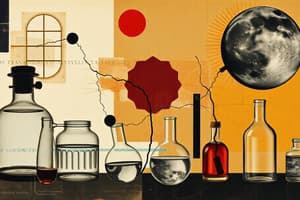Podcast
Questions and Answers
What defines a pure substance?
What defines a pure substance?
- A substance that can be separated into its components by physical means.
- A substance that cannot dissolve in any solvent.
- A mixture of different compounds that retains certain properties.
- A substance that contains only one type of particle. (correct)
Which of the following is an example of an impure substance?
Which of the following is an example of an impure substance?
- Oxygen gas
- Distilled water
- Pure water
- Sea water (correct)
What is the function of a solvent in a solution?
What is the function of a solvent in a solution?
- The medium in which the solute is dissolved. (correct)
- The substance that causes the solution to become cloudy.
- The solid component that can be separated by filtration.
- The solute that gets dissolved.
What is the purpose of filtration?
What is the purpose of filtration?
How is crystallisation commonly used?
How is crystallisation commonly used?
Which technique utilizes differences in boiling points to separate components?
Which technique utilizes differences in boiling points to separate components?
In chromatography, what is the significance of solubility?
In chromatography, what is the significance of solubility?
Why is blood classified as a mixture?
Why is blood classified as a mixture?
What should be done to ensure safety when conducting laboratory experiments?
What should be done to ensure safety when conducting laboratory experiments?
In an investigation, the variable that is deliberately changed is called what?
In an investigation, the variable that is deliberately changed is called what?
Which type of graph would be most appropriate to show the change in temperature over time?
Which type of graph would be most appropriate to show the change in temperature over time?
How can the reliability of gathered data be assessed?
How can the reliability of gathered data be assessed?
What happens to particles when heat energy is removed from them?
What happens to particles when heat energy is removed from them?
What is the primary effect of evaporation on the particles of a liquid?
What is the primary effect of evaporation on the particles of a liquid?
How should data be presented to effectively summarize findings?
How should data be presented to effectively summarize findings?
What does density explain in terms of the behavior of matter?
What does density explain in terms of the behavior of matter?
Flashcards are hidden until you start studying
Study Notes
Safety Precautions for Experiments
- Always wear safety goggles to protect your eyes from splashes or projectiles.
- Use a lab coat to protect your clothing from spills.
- Tie back long hair to prevent it from catching on fire or equipment.
- Never eat or drink in the lab, and always wash your hands thoroughly before leaving.
- Follow instructions carefully and ask for help if you are unsure about anything.
Drawing Experiment Setups
- Use standard symbols and conventions to represent different equipment.
- Clearly label each piece of equipment and its purpose.
- Follow the order of the steps in the experiment.
- Use arrows to indicate the flow of materials or processes.
Identifying Controlled Variables
- Controlled variables are factors that must remain constant during an experiment to get reliable results.
- For example, if you are testing the effect of temperature on plant growth, you would need to control the amount of light, water, and nutrients the plants receive.
- Techniques for control could include using measurement tools, adjusting settings, and creating controlled environments.
Independent and Dependent Variables
- The independent variable is the factor that is being changed in the experiment.
- The dependent variable is the factor that is being measured in response to the independent variable.
- For example, in the plant growth experiment, the independent variable is temperature and the dependent variable is plant height.
Units of Measurement
- Use the appropriate SI units for all measurements.
- For example, measure length in meters, mass in kilograms, volume in liters, and temperature in degrees Celsius.
Safe Equipment Use
- Read and understand the instructions for each piece of equipment before using it.
- Ask for help if you are unsure about how to use a piece of equipment properly.
- Do not use equipment that is damaged or malfunctioning.
- Follow safety procedures for each specific piece of equipment.
Safety Issues in the Lab
- Be aware of potential hazards and follow procedures to minimize risks.
- Use caution when handling chemicals, hot plates, glassware, and sharp objects.
- Know the location of safety equipment, such as fire extinguishers, eyewash stations, and first aid kits.
- Report any accidents or spills to the teacher immediately.
Assessing Experiment Methods
- Identify strengths and weaknesses in the experimental procedure.
- Suggest improvements to the method for greater accuracy and reliability.
- Consider factors like sample size, control of variables, and data collection methods.
Summarizing Data and Information
- Present data clearly and concisely using tables, graphs, and diagrams.
- Calculate means, averages, and other statistical measures as needed.
- Identify patterns and trends in the data.
- Draw conclusions based on the evidence.
Representing Data
- Choose the most appropriate graph type for the data (histogram, column, sector, or line graph).
- Use clear labels and scales.
- Include a legend or key if necessary.
- Present the data in a way that is visually appealing and easy to understand.
Data Extraction
- Accurately extract information from diagrams, flowcharts, tables, databases, and graphs.
- Use appropriate units of measurement.
- Pay attention to the scales and units on graphs.
- Use critical thinking skills to analyze the data and draw inferences.
Data Analysis
- Apply simple numerical procedures like calculating means/averages.
- Compare data from different sources to assess its reliability.
- Identify correlations and relationships between different variables.
- Use data analysis techniques to draw conclusions and make predictions.
Question Investigation and Solutions
- Identify scientific problems for investigation.
- Formulate a hypothesis based on scientific knowledge and observations.
- Conduct experiments to test the hypothesis.
- Analyze the data and draw conclusions.
- Propose solutions to problems based on the findings.
Presenting Scientific Findings
- Use scientific language to present ideas and solutions.
- Organize information in a logical and clear manner.
- Use appropriate text types, including discussions, explanations, and procedures.
- Engage the audience with visual aids and interactive elements.
Graph Construction
- Select the most appropriate type of graph to represent the data.
- Use clear and consistent labeling for all axes, data points, and legends.
- Ensure the data is presented accurately and efficiently.
- Use color and other visual elements to enhance clarity.
Identifying Scientific Investigations
- Identify questions that can be explored through scientific investigation.
- Formulate hypotheses based on existing scientific knowledge.
- Design experiments to test the hypotheses and collect data.
- Analyze the data and draw conclusions.
- Communicate the findings of the investigation.
Making Predictions
- Use scientific knowledge and observations to make predictions.
- Consider the relationships between variables and patterns in data.
- Make predictions based on sound scientific reasoning.
- Test predictions through further investigation.
Matter and Particles
- Matter is made up of tiny particles that are constantly moving and interacting.
- The amount of heat energy possessed by particles affects their movement.
- More heat energy leads to faster particle motion.
- This movement can change the state of matter (solid, liquid, gas).
Particle Movement and State Changes
- Evaporation: liquid particles gain enough energy to escape into the air.
- Condensation: gas particles lose energy and become liquid.
- Boiling: liquid particles gain enough energy to change rapidly into gas.
- Melting: solid particles gain enough energy to move more freely and become liquid.
- Freezing: liquid particles lose energy and become solid.
Density and Particle Model
- Density is a measure of how tightly packed the particles are in a substance.
- Denser substances have more particles in a given volume.
- The particle model helps explain density by illustrating the arrangement and spacing of particles.
Models and Properties of Matter
- Models are useful tools for explaining the properties of solids, liquids, and gases.
- However, models have limitations, and they may not always accurately represent complex phenomena.
Pure Substances, Impure Substances, and Mixtures
- A pure substance is made up of only one type of particle (element or compound).
- An impure substance is a mixture of two or more pure substances.
- Mixtures can be separated into their components.
- Mixtures can be homogeneous (uniform composition) or heterogeneous (non-uniform composition).
Solvent, Solute, Solution, Aqueous
- A solvent is a substance that dissolves another substance.
- A solute is the substance that is dissolved.
- A solution is a homogeneous mixture of a solute and a solvent.
- Aqueous solutions are solutions where water is the solvent.
- Soluble substances dissolve in a solvent.
- Insoluble substances do not dissolve in a solvent.
Importance of Water as a Solvent
- Water is an essential solvent in many aspects of life, industry, and the environment.
- It dissolves nutrients in soil, transports substances in organisms, and plays a vital role in chemical reactions.
- Industrial processes rely on water as a solvent for cleaning, manufacturing, and processing.
- Water's ability to dissolve substances makes it essential for maintaining the balance of ecosystems.
Separation Techniques
- Decantation: separating a liquid from a solid by carefully pouring the liquid off.
- Filtration: separating a solid from a liquid by passing the mixture through a filter.
- The filtrate is the liquid that passes through the filter.
- The residue is the solid that remains on the filter.
Applications of Filtration and Decantation
- Preparing yams: washing and straining yams to remove dirt and debris.
- Water filtration plants: removing impurities from water for drinking.
Evaporation
- Evaporation: separating a dissolved substance from a solution by heating the solution and allowing the solvent to evaporate.
- Used in everyday life for drying clothes, making salt from seawater, and concentrating solutions in industry.
Crystallisation
- Crystallisation: separating a soluble substance from a solution by allowing the solvent to evaporate slowly, which causes the dissolved substance to crystallize out of solution.
- Used to obtain pure substances from mixtures.
Distillation
- Distillation: separating a mixture of liquids with different boiling points.
- Heat the mixture, causing the liquid with the lower boiling point to evaporate first.
- The evaporated liquid is then condensed and collected as the distillate.
- The liquid with the higher boiling point remains in the original container as the residue.
Chromatography
- Chromatography: separating a mixture of soluble substances based on their different affinities for a stationary phase (solid) and a mobile phase (liquid or gas).
- Used in various applications, such as separating pigments in ink, identifying chemical compounds, and analyzing blood samples.
Blood as a Mixture
- Blood is classified as a mixture because it contains various components, including red blood cells, white blood cells, platelets, and plasma.
- These components are not chemically bonded, and they can be separated using different techniques.
Classification of Living Things
- Living things are classified into different groups based on their shared characteristics, such as their physical features, reproductive methods, and evolutionary history.
- Classification helps us understand the relationships between organisms and organize the vast diversity of life on Earth.
Similarities and Differences
- By examining similarities and differences between organisms, scientists can group them into categories that reflect their evolutionary relationships.
- This allows us to study the diversity of life and understand how organisms are related to each other.
Studying That Suits You
Use AI to generate personalized quizzes and flashcards to suit your learning preferences.




